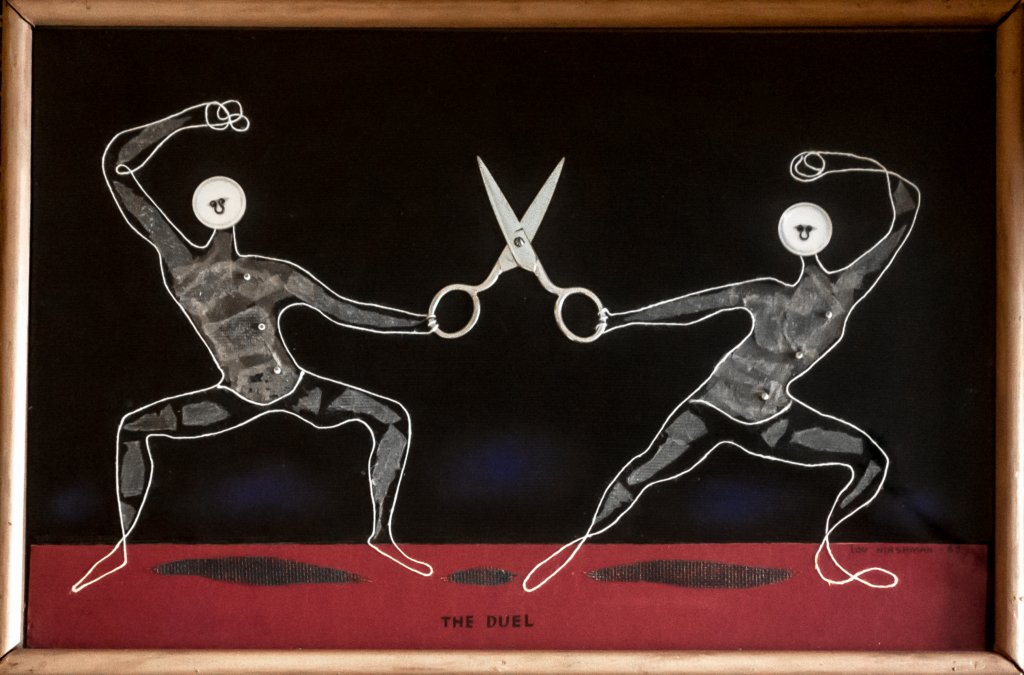Why Hirshman’s Fidel Castro went into hiding

One day when I was about 10, I came home from school. The weather outside was lousy, so there were no kids on the street to play with. Instead, I sat down at the dining table in the living room to do my homework. My studies consisted of analyzing the acumen of leporidae in Bugs Bunny cartoons and the pitfalls of human interaction as depicted in The Three Stooges, all courtesy of our old Zenith TV.
At dinnertime, I sat down in that very same living room with my sister and mom. My dad, the artist Lou Hirshman, as usual, wasn’t there since he worked weekday evenings at a free art school.
What happened next was a lesson in what it really means to see – or not see.
As I was raising a fork to my mouth, I noticed my mom sitting across the table staring at me with a quizzical expression. She asked me if I saw anything new in the room, a room I had been wasting away much of the afternoon in. I looked around and shrugged my shoulders.
Then I saw why my mom had been staring at me.

There in a wooden frame above the couch was a new artwork my dad had created. It was his caricature of the Cold War Cuban leader Fidel Castro, an eye-catching work that had not caught my eye. My blindness was not a matter of out of sight, out of mind. The Castro piece was very much in sight.
So why didn’t I see this witty piece of art my dad probably had spent months working on?
Walls.
Walls are utilitarian. At home – aside from a physical means of separating family members to keep them from killing each other and being something to bump into in the dark of night when you get up to use the bathroom – practically their only reason for existing in the last decade has been to provide vertical surfaces on which to hang our big screen TVs. We stare at these screens for hours.
But any artworks – be they portraits, landscapes, historical representations, surreal dreams or abstracts – that happen to be hanging on those same walls remain largely unseen. They get little observational respect. Neither do the artists who created them, unless some patron of the arts, vociferous and well-heeled, is singing their praises.
What art?
You disagree? When was the last time that you went to someone’s home, to an office or public building, perhaps a hotel room, and noticed any artwork hanging on the walls? My guess is rarely. Oh, you might be aware there is something on the wall but not what the something is. Confront a person who has just left such a structure about the art on the walls, I suspect most would say, “What art?”
Why? We simply don’t look at walls – except maybe when we visit an art gallery or museum, structures that are basically blank roof-covered canvases. But in most cases, art pieces on walls are rarely noticed, rarely appreciated, rarely loved.
They become wallflowers.
Does the artist care that their work may be used merely as something to hide the monotony of a nondescript wall? The purist might say no, that artists create art that is personal, for themselves, viewers be damned. But even the most reclusive of visual artists – these outsiders living inside the walled off worlds of their studios and their minds – must at some point long to know whether their creative endeavors have touched someone. All it would take is a comment of a stranger. The reaction of a friend. Or the smile and nod of a loved one.
My smile?
My nod?
No, I’m afraid not.
I didn’t look close enough.
Or at all.
Examining Castro



But the times have changed. Now I look at my dad’s Castro (unfortunately just a photograph as the original was sold long ago). Despite the two-dimensional representation I marvel. I wonder what came first – my dad’s decision to do the Cuban leader in caricature after watching the evening TV news or the windings of an old chain lying on the basement floor that revealed itself as a beard of note? How did my dad come up with the idea to translate the leader’s iconic army cap into an opened sardine can? Or use a thimble for the ashes on Castro’s signature Cuban cigar? And what about that life-like banana nose? Most think it is real. But my dad had the uncanny ability to craft what appear to be biodegradable perishables into rock-solid edible lookalikes that would last forever, an unappreciated artistry in its own right.
He would then unite these few found objects with tough wire to a backboard inside a rectangular frame, morphing the few disparate items into the visage of Castro. Or Adolf Hitler (8 objects). Or Mussolini (7 objects). Or Nikita Khrushchev (6 objects), Albert Einstein (5 objects), Haile Salassie (4 objects), John D. Rockefeller (3 objects). The same for my dad’s non-celebrity period, such as Ballerina, deceptively simple – a clothes hanger, nail files, nuts

How did he do it?
How did he see what he saw?
Respect for the artist
Granted, my dad’s work may have more eye-catching appeal than most art, given its humor and an attraction for both the young and old. But even his creations often get neglected. I have three of his pieces hanging in my house, my favorite being The Duel in which two button-faced, foil-clenching competitors each fashioned from one length of string in an eternal battle connected by the never-to-be separated swords of a pair of child’s scissors. Amazing. But it is a rare occurrence that a visitor comments on this work or any of the other pieces.

Pity the unappreciated artist.
So the next time you go to an indoor space, check to see if the walls have found more of a reason for existing than to close off spaces and the people in them. Even if you have thrown a glance at a particular piece of hanging art before, look again.
Look for the details.
Look for the artist.
And then the walls holding the art will fade away.
And the wilting wallflowers will spring to life.
And walls will never look the same again.
William P. Hirshman
December 2022
Administrator’s note: The Lou Hirshman website is being revamped, but the full gallery and blog stories can still be viewed. If you decide to make a comment – positive or negative – please leave them both on the Facebook page and the website.
Administrator’s note #2: Members of the Lou Hirshman Group will receive a special “Season’s Greetings” present on Dec. 24. Till then.

